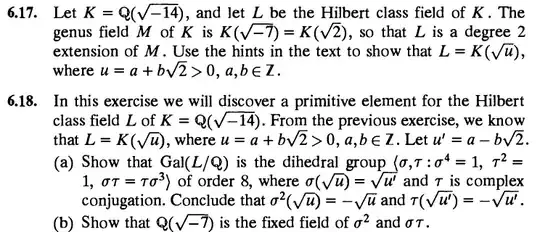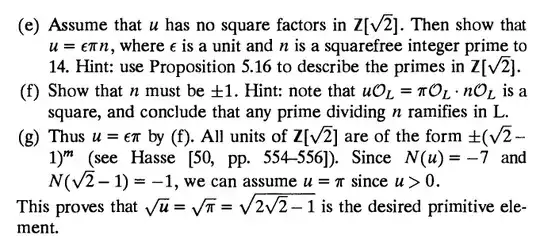Partial answer. Feedback and corrections always welcome!
(a) I was not able to solve this part of the exercise in a satisfactory way. However, one way to approach it would be to show that $Gal(L/K) = \mathbb{Z}_4$. Next, one could invoke the following theorem

to find that $Gal(L/\mathbb{Q})$ is the dihedral group of order $8$. I would like to avoid this advanced approach. There must be a much simpler approach using only Galois theory. Can somebody help me?
(b) idem.
(c) A straightforward calculation shows that
$$\begin{eqnarray}
\sigma^2(\sqrt{uu'}) &=&\sigma\left(\sigma(\sqrt{u} \sqrt{u'})\right) \\
&=&\sigma\left(\sigma(\sqrt{u}) \sigma (\sqrt{u'})\right) \\
&=& \sigma \left (\sqrt{u'} (- \sqrt{u})\right) \\
&=& \sigma (\sqrt{u'}) \sigma(- \sqrt{u})) \\
&=& -\sqrt{u} (- \sqrt{u'}) \\
&=& \sqrt{uu'}
\end{eqnarray}$$
$$\begin{eqnarray}
\sigma \tau (\sqrt{uu'}) &=& \sigma \left( \tau (\sqrt{u} \sqrt{u'})\right) \\
&=& \sigma \left( \tau (\sqrt{u}) \tau( \sqrt{u'})\right) \\
&=& \sigma \left ( \sqrt{u} (- \sqrt{u'}) \right) \\
&=& \sigma( \sqrt{u}) (- \sigma(\sqrt{u'})) \\
&=& \sqrt{u'} (- (-\sqrt{u})) \\
& =& \sqrt{u u'}
\end{eqnarray}$$
This shows that $\sqrt{uu'}$ is fixed by both $\sigma^2$ and $\sigma \tau$. Hence, by part (b) this means that $\sqrt{uu'}$ lies in the fixed field $\mathbb{Q}(\sqrt{-7})$. Say that $\sqrt{uu'}=a+b\sqrt{-7}$ for some $a,b \in \mathbb{Q}$, then
$$\begin{eqnarray}
- a - b \sqrt{-7} &=& -(a+b\sqrt{-7}) \\
&=& - \sqrt{uu'} \\
&=& \tau(\sqrt{uu'}) \\
&=& \tau (a+b\sqrt{-7}) \\
&=& \tau(a) + \tau(b\sqrt{-7}) \\
&=& a - b\sqrt{-7} \\
\end{eqnarray}$$
such that $a=0$. Hence $\sqrt{uu'}=m \sqrt{-7}$ for some $m \in \mathbb{Z}$. To see why $m$ is indeed an integer, and not a rational number, square both sides.
(d) Observe that
$$N(u)=N(a+b\sqrt{2})=a^2 - 2b = (a+b\sqrt{2})(a-b\sqrt{2})=uu' = -7m^2$$
Furthermore, since $\mathbb{Z}[\sqrt{2}]$ is a UFD and $u=a+b\sqrt{2}$, we can factor $u$ uniquely, say
$$u=p_1^{e_1} \cdots p_r^{e_r}$$
Taking norms we see that at least one of those primes needs to have norm $-7$. The exercise suggests that this element will be $\pi=2 \sqrt{2}-1$.
$\color{red}{\text{But how can I conclude that this is the only possibility?}}$ Probably there are many more elements with norm $-7$, right? Anyway, let $\alpha$ be everything besides $\pi$ in the above factorization, then $N(\alpha)=m^2$, and $\alpha$ is the desired element.
(e) $\color{red}{\text{Why can one assume that there are no square factors of $u$ in the ring $\mathbb{Z}[\sqrt{2}]$?}}$ This is not the question at stake, but I would like to know why.
Anyway, since $N(\alpha)=N(m)$, both elements must differ by a unit $\epsilon$, i.e. $\alpha = \epsilon \cdot m$. Hence $u = \pi \alpha = \epsilon \pi n$. The change of $m$ to $n$ in the exercise only seems to be a notational convenience.
By a famous theorem of Dedekind, one can now determine the prime elements. This question was also raised here. However, Alex Youcis claims his answer was incomplete. He basically outlines two options. But in the context of my exercise, it seems that I only need to have option one, namely
$$p \equiv 3, 5 \mod{8}$$
$\color{red}{\text{I don't see why the other option must be excluded}}$. Anyway, combining this with the above, and the fact that $u$ has no squares (why?), we get that
$$u=\epsilon \pi (p_2 \ldots p_r)$$
with $p_2,\ldots p_r$ integer primes. From $p \equiv 3,5 \mod{8}$ it is clear that none of the above integer primes can be equal to $2$ or $7$.
(f) Now,
$$ u \mathcal{O}_L = \pi \mathcal{O}_L \cdot n \mathcal{O}_L$$
with $u = \sqrt{u}\sqrt{u}$ a square. This is clear, one just has to recall that one is working again in the bigger ring and no longer in $\mathbb{Z}[\sqrt{2}]$. As a consequence, each prime which divides $n$ ramifies in $\mathcal{O}_L$. On the other hand, there is a famous theorem which says that
$$p \textrm{ ramifies in } L \Leftrightarrow p \mid d_k$$
Since $d_k=56$, we have that $p=2$ and $p=7$ would ramify in $L$. But this would mean that $p=2,7$ divides $n$. But this is a contradiction because of part (e). I need to refine this argument somewhat more, but from this I must conclude that $n=\pm 1$.
(g) From the previous part we know that $n = \pm 1$. Assume $n=1$ and write
$$u = \epsilon \pi$$
If $n=-1$ just change the unit to $\epsilon'$. We know that all units in $\mathbb{Z}[\sqrt{2}]$ are of the form $\pm (\sqrt{2} - 1)^m$. Now, by our original assumption (again: why?), $u$ had no square factors, hence we should not consider anything of the form $\pm (\sqrt{2}-1)^{even}$. So, we only consider $\epsilon = \pm (\sqrt{2}-1)^{odd}$. But, since
$$N(\epsilon) = N(\pm (\sqrt{2}-1)^{odd})=-1$$
and
$$-7 = N(u)=N(\epsilon) N(\pi) = -7 N(\epsilon),$$
this can never happen. So the only possiblity left is that $\epsilon= \pm 1$. But since $\pi = 2 \sqrt{2} - 1 > 0$ and $u>0$ by assumption, we can conclude that $\epsilon=1$.
Conclusion: Putting everything together we have that $u = \pi = 2 \sqrt{2} - 1$ and this gives us the primitive element for the Hilbert Class Field
$$L=K\left(\sqrt{2 \sqrt{2} - 1}\right)$$



